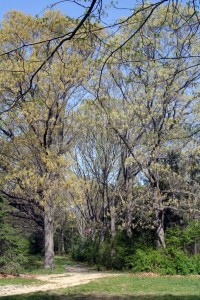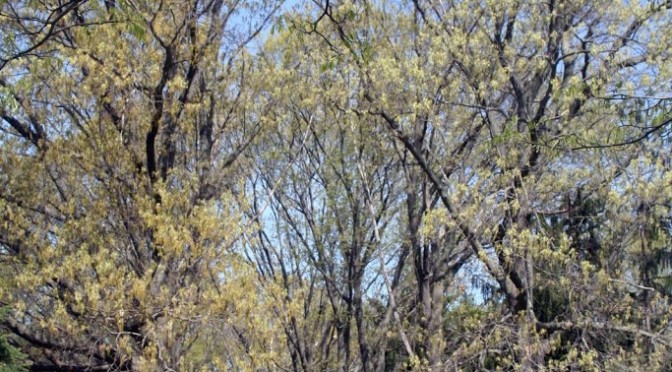 If you’re looking for gorgeous spring warbler pics, you’ll have to go elsewhere. The best I can manage so far this season is mediocre photos of the trees I often find them feeding in. These are red oaks (I think) and there’s an overgrown arboretum near to my hometown that has lots of them. I like to position myself on this dirt path that’s lined on both sides by these trees and see what I can find feeding way up in the tippy-tops of the trees. The other day there were mostly black-throated greens and northern parulas, but I also saw a great-crested flycatcher and strangest of all a chipping sparrow! Isn’t he supposed to be feeding on the ground like a proper sparrow?
If you’re looking for gorgeous spring warbler pics, you’ll have to go elsewhere. The best I can manage so far this season is mediocre photos of the trees I often find them feeding in. These are red oaks (I think) and there’s an overgrown arboretum near to my hometown that has lots of them. I like to position myself on this dirt path that’s lined on both sides by these trees and see what I can find feeding way up in the tippy-tops of the trees. The other day there were mostly black-throated greens and northern parulas, but I also saw a great-crested flycatcher and strangest of all a chipping sparrow! Isn’t he supposed to be feeding on the ground like a proper sparrow?
I’m curious if others north or south (or west) of NJ find a similar preference for red oaks when they’re in flower or if there’s some other type of tree you loiter under looking for warblers?

I find alot of my spring warblers in the hardwoods “Maple,Popular ect…”I also find many along the river.
I found plenty of Warblers but don’t have too much luck getting there pictures-I like to find places that I’m level with the treetops so I don’t have to look up so much.
Laura, I’m not experienced at all with warblers but I believe I’ve spotted Pine Warblers here in NC. Never been able to get a decent photo for ID.
I was amazed to find a Chipping Sparrow at my feeder today. I’ve always seen them on the ground or in trees, but never at a feeder.
As usual, no help here :o)
Mary: I have Chippies coming to my feeder also – I agree it’s strange to see them anywhere but on the ground.
I really think the trick to fidning them Mary is learning their songs – they’re so tiny and move so quickly it’s easy to miss them unless you know to look for them!
Oh – and I haven’t seen a Pine Warbler this spring, but I’ve heard them singing in… the Pine Barrens! Their song is very similar to the Chipping Sparrows song.
Larry: That’s a good strategy to avoid warbler neck! You’ve had some nice pics of migrants lately, I think.
Jimmy: Yes – water is a big draw! Are trees leafing out and blooming by you already?
Chipping sparrows include insects in their diet, so it is possible they find some of those in trees. It may well have been using the tree as a singing platform.
Aside from the obvious ones, I can’t say that I have noticed consistent preferences. I see warblers in hardwoods more than conifers, but there are always exceptions. Most of my birding takes place in oak-beech-maple forests. I find more warblers on the edge than in the interior. The best are places where there is a full vertical range of vegetation from ground to treetop. Also, Larry is right about elevation – hilltops are sometimes better than valleys if all else is equal.
There is a book called “The Complete Birder” that explains how to use vegetation levels to find warblers. I’m not sure if it is still in print.
I just go and sit. And pray that some warblers fly through.
🙂
I’m not having much luck finding bird diversity yet this year. I keep trying though. 🙂
Here’s my guess: The birds go where the insects are. Maybe the hatching of bug eggs is timed to the opening of the flowers so the larvae have plenty to eat. The birds figure this out. I wonder if they see or smell the flowers or the caterpillars.
My oaks (no reds here) were alive with warblers earlier. I find them in live oaks, laurel oaks, cypress swamps, willows by the pond, etc.
I’m loitering under huge pin oaks–and I sympathize with your difficulty in getting a close view of anything. Maybe if I knew my songs better?
Oaks are definitely popular from what I’ve observed here in NJ. I think MokoMan is right about the flowers.
without a doubt, I hear many more warbler species than I see! Great list of birds you have!